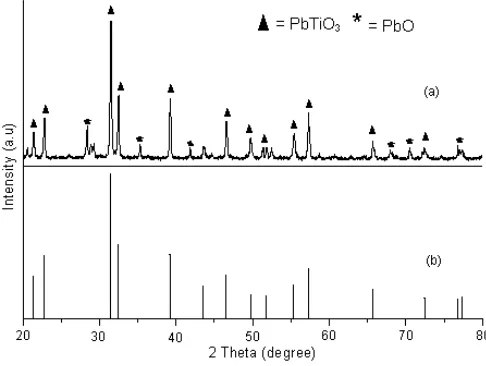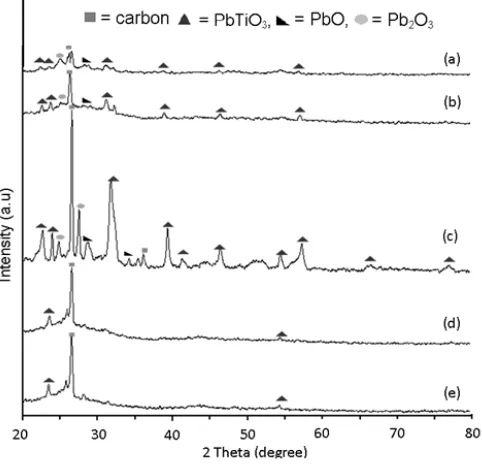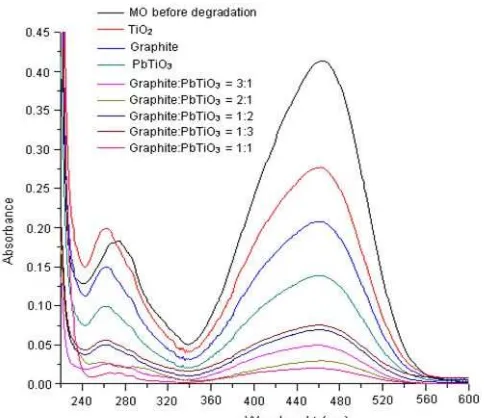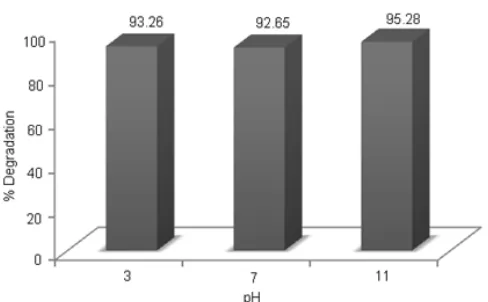Photocatalytic and Photoelectrocatalytic Degradation of Methyl Orange
Using Graphite/PbTiO
3Composite
Candra Purnawan
*, Sayekti Wahyuningsih, and Pramudita Putri Kusuma
Department of Chemistry, Faculty of Mathematics and Natural Sciences, Sebelas Maret University Jl. Ir. Sutami 36A, Surakarta 57126, Indonesia
Received February 23, 2016; Accepted May 11, 2016
ABSTRACT
Synthesis of graphite/PbTiO3 composite as a catalyst in photodegradation and photoelectrodegradation process of methyl orange have been conducted. The purposes of this research are to study the effect of radiation time, composition of composite, voltage and pH of solution for methyl orange degradation. Photodegradation process of methyl orange was carried out for 5; 10; 15; 20; 25 and 30 min. Ratio of graphite : PbTiO3(w/w) were varied at 1:3; 1:2; 1:1; 2:1 and 3:1. Meanwhile, the applied voltages were 7.5; 10 and 12.5 V and the photoelectrodegradation was conducted under pH condition of 3; 7; and 11, respectively. The result showed that optimum composition of graphite/PbTiO3in the methyl orange photodegradation was obtained at 1:1 ratio for 30 min with degradation up to 90.43% ± 0.062. The degradation reaction follows first order reaction with a rate constant of 0.0688 min-1. The optimum voltage is 10 V, in which it reduced the methyl orange concentration up to 92.65% ± 0 with a rate constant 0.0941 min-1 for first order reaction. The optimum pH is pH = 11, that provide methyl orange reduction up to 95.28% ± 0.082.
Keywords:graphite/PbTiO3; methyl orange (MO); photodegradation; photoelectrodegradation
ABSTRAK
Penelitian tentang sintesis komposit grafit/PbTiO3sebagai katalis fotodegradasi dan fotoelektrodegradasi metil oranye telah dilaksanakan. Penelitian ini bertujuan untuk mengetahui pengaruh waktu radiasi, komposisi komposit grafit/PbTiO3, beda potensial, dan pH larutan terhadap degradasi metil oranye. Fotodegradasi metil oranye dilakukan dengan waktu radiasi selama 5, 10, 15, 20, 25, dan 30 menit dengan rasio komposisi grafit/PbTiO3 1:3, 1:2, 1:1, 2:1, 3:1. Sedangkan fotoelektrodegrasi metil oranye dilaksanakan dengan beda potesial 7,5; 10,0; dan 12,5 V dengan kondisi pH larutan sebesar 3, 7, dan 11. Hasil penelitian menunjukkan komposisi optimum grafit/PbTiO3 dalam degradasi metil oranye adalah 1:1 selama 30 menit hingga 90,43% ± 0,062. Fotodegradasi metil oranye mengikuti orde reaksi 1 dengan konstanta laju reaksi 0,0688 menit-1. Beda potensial optimum fotoelektrodegradasi metil oranye diperoleh pada 10 V hingga 92,65% dan mengikuti orde reaksi 1 dengan konstanta laju reaksi sebesar 0,0941 menit-1. Sedangkan pH optimum adalah pH = 11 dengan degradasi hingga 95,28% ± 0,082.
Kata Kunci:grafit/ PbTiO3; metil oranye (MO); fotodegradasi; fotoelektrodegradasi
INTRODUCTION
Titanium dioxide (TiO2) has been widely used in
various application in recent years, such as for purification of water and air, destruction of microorganism such as bacteria and viruses, the manufacture of hydrogen gas from water [1], as well as the photocatalyst on the degradation process an organic pollutant [2-7]. TiO2 widely applied as a photocatalyst
because it has a high photoactivity, inert, inexpensive and non-toxic [8-9]. However, TiO2 still has
disadvantages about bandgap (Eg), which is TiO2 has
wide bandgap (Eg) (3.2 eV) and its ability to experience
recombination of electron-hole so that decreasing of catalytic activity [10]. To improve the catalytic ability,
then the modification to perform the synthesis of TiO2
compounds derivative such as PbTiO3 in order to
obtained material that has a better catalytic ability. PbTiO3 has a band gap energy smaller than TiO2 i.e.
2.75 eV. Therefore, the excitation of electron from valence band to conduction band might occur easier [15].
Pb oxide is a semiconductor material from transition metal ion Pb2+is known to absorb visible light because it has small band gap energy [12]. In addition, Pb oxide has a high conductivity, therefore it also widely used as an electrode for the degradation of organic pollutants [13-14]. To optimize of degradation ability of PbTiO3, then addition of graphite to form
waste from a dry cell battery. Graphite is an electrode with high resistant at high temperature [15]. Moreover, graphite is widely used as an adsorbent for organic pollutants and also as an electrode for photoelectrocatalytic process due to its high electrical conductivity [16-20].
In this research, graphite/PbTiO3 composite
powder was prepared by sol-gel method. The powder then to be used in photocatalytic process. In addition, this research also prepared an electrode from the composite which was used for photoelectrocatalytic process. The crystalline structure and surface morphology of graphite/PbTiO3 composite were
analyzed with XRD and SEM. The effect of the ratio of graphite:PbTiO3 was studied. The photocatalytic
oxidation of Methyl Orange (MO) (Fig. 1) using grafit/PbTiO3 composite powder with various ratio
graphite and PbTiO3 were investigated. The
photoelecrocatalytic ability of this composite and the effect of potential and pH on this photoelectrocatalytic process were discussed.
EXPERIMENTAL SECTION
Materials
Titanium tetraisopropoxide (TTIP) (Aldrich), acetic acid glacial (Merck), Pb(NO3)2 (Merck), silica glue
(Autosil Black Gasket RTV Silicone), graphite from dry cell, nitric acid (Merck), potassium chloride (Merck), hydrochloric acid (Merck), sodium hydroxide (Merck) and methyl orange (Merck).
Instrumentation
Glassware, oven, furnace (Thermolyne 48000), centrifuge (Profuge 6K). X-ray data were collected by
using a Shimadzu XRD-6000 based on CuKα radiation.
Surface morphology was obtained by a FEI Inspect-S50, EDAX Ametex). Absorbance of dye solution was obtained by a UV-Vis Spectrophotometer (Perkin Elmer Lambda 25). Electrochemical experiments were performed with a DC Power Supply (ATTEN TPR6005S). The two electrode system consisted of a graphite/PbTiO3 electrode as the working electrode and
a graphite electrode as the counter electrode, as shown in Fig. 2. The radiation source was a UV lamp (9 W).
Procedure
Pretreatment of graphite
Graphite rods of dry cell batteries was pulverized into fine powder and then soaked with a solution of HNO3 0.1 M for 24 h. Then, it was filtered, washed with
distilled water until continued with filtration and drying at
Fig 1.Structure of Methyl Orange
Fig 2.Photoelectrocatalytic degradation reactor
room temperature. The prepared graphite powder then was sieved into 100 mesh size.
TiO2preparation
A 10 mL solution of TTIP was hydrolyzed in the 100 mL acetic acid glacial solution and mixed under vigorous stirring in a waterbath (14 °C) until a solution of TiO2 nanocrystals was formed. The solution was
heated at 90 °C to became a gel. The gel formed, then was heated in the oven at 150 °C for 24 h to undergo an aging process. Next, the TiO2 xerogel was ground
and pulverized into a fine powder and calcined in a furnace at 400 °C for 2 h to obtain nanocrystalline anatase phase.
Preparation of PbTiO3
A 10 mL solution of TTIP was hydrolyzed in the 100 mL acetid acid glacial solution and mixed under vigorous stirring in a waterbath (14 °C) until a solution TiO2 nanocrystals was formed. The solution was
heated at 90 °C until became a gel, Pb(NO3)2 was
added and stirred until became sol. The sol was placed in an oven at 150 °C for 24 h to undergo an aging process. Next, the PbTiO3 xerogel was ground and
pulverized into a fine powder and calcined in a furnace at 400 °C for 2 h.
Preparation of graphite/PbTiO3composite
vigorous stirring in a waterbath (14 °C) until a solution TiO2 nanocrystals was formed. The solution was heated
at 90 °C until became a gel, Pb(NO3)2 was added and
stirred until became sol. Then, the graphite powder was added to the mixture. The sol was placed in an oven at 150 °C for 24 h to undergo an aging process. Next, the xerogel was ground and pulverized into a fine powder and calcined in a furnace at 400 °C for 2 h.
This method carried out with various of ratio graphite : PbTiO3(w/w) were 1:3, 1:2, 1:1, 2:1 and 3:1.
Preparation of graphite/PbTiO3composite electrode Graphite/PbTiO3composite powder was mixed with
silica glue at a ratio (w/w) 4:1 and it was given the pressure of 1000 psi until an electrode rod was formed. Furthermore, the electrode rod was placed in an oven at 120 °C for 6 h in order to obtain electrode which was ready for use.
Photodegradation of methyl orange
In order to investigate the photocatalytic (PC) activity of the graphite/PbTiO3 composite powder, a
series of degradation experiments of methyl orange in aqueous solutions were performed. The initial concentration of methyl orange was 5 mg L-1. The total volume of solution was 20 mL. The front of the reactor was irradiated with a 9 W UV lamp and the progress of the photocatalytic degradation was recorded by UV-VIS spectroscopy. The PC degradation of MO was performed at radiation time of 5 to 30 min and at various ratio graphite and PbTiO3.
Photoelectrodegradation of methyl orange
In order to investigate the photoelectrocatalytic (PEC) activity of the graphite/PbTiO3composite, a series
of degradation experiments of methyl orange in aqueous solutions were performed. The initial concentration of methyl orange was 5 mg L-1, with KCl 0.1 M used as the supporting electrolyte. The total volume of solution was 20 mL. Experiments were carried out with two electrode system. A graphite electrode was used as the counter electrode and a graphite/PbTiO3 composite electrode as
the working electrode. The front of the working electrode was irradiated with a 9 W UV lamp and the progress of the photoelectrocatalytic degradation was recorded by UV-VIS spectroscopy. The PEC degradation of MO was performed at voltages of 7.5 V to 12.5 V and at various pH.
RESULT AND DISCUSSION
The Characteristics of TiO2
The TiO2powder prepared by sol-gel method from
Titanium tetra isopropoxide precursor was characterized
Fig 3. XRD pattern of TiO2 (a) as compared with
JCPDS Standard 86-1157 (b), A = TiO2anatase
Fig 4. XRD pattern of PbTiO3 (a) as compared with
JCPDS Standard 74-2495 (b)
by XRD, as shown in Fig. 3. In this method, TiO2
synthesis was carried out under acidic condition with acetic acid glacial as solvent.
The use of acetic acid glacial as solvent, as well as activating the formation of Ti complexes and via hydrolysis and condensation steps, nano-TiO2 will be
formed. Heating at 90 °C aims to evaporate the solvent thus forming a TiO2 sol-gel. Whereas, to remove
organic impurities and residue of solvents, the sample was heated at 150 °C to form a TiO2xerogel. Annealing
process at 400 °C is to form anatase phase of TiO2.
Fig. 3 shows that the XRD pattern of TiO2 exhibits strong diffraction peaks at 2θ = 25.320°; 2θ = 37.860° and 2θ = 48.060°indicating that TiO2 is formed by the
Fig 5.XRD pattern of Graphite/PbTiO3composite (a) 1:3
(b) 1:2 (c) 1:1 (d) 2:1 (e) 3:1
Fig 6. Surface morphology of (a) Graphite (b) Graphite/PbTiO3composite ratio 1:1
Fig 7. Degradation of MO after PC for 30 minutes with variation composition of Graphite/PbTiO3composite
The Characteristics of PbTiO3
PbTiO3 compound was obtained after an
annealing process at 400 °C for 2 h. Fig. 4 shows that the XRD pattern of PbTiO3 exhibits strong diffraction peaks at 2θ = 21.419°; 2θ = 22.810°; 2θ = 31.480°; 2θ = 32.461°; 2θ = 39.217°; 2θ = 43.589°; 2θ = 46.564°; 2θ = 49.717°; 2θ = 51.778°; 2θ = 55.387°; 2θ = 57.283°; 2θ = 65.676° and 2θ = 72.420°. All peaks are in a good agreement with the standard spectrum JCPDS No. 74-2495 for PbTiO3and
No. 85-0711 for PbO. Based on that diffractogram, the abundance of PbTiO3 was 90.16%. Diffractogram of
PbTiO3 is completely different with diffractogram of
TiO2 anatase that have strong diffraction peaks at 2θ = 25.320°; 2θ = 37.860° and 2θ = 48.060°.
The Characteristics of Graphite/PbTiO3Composite
The graphite/PbTiO3Composite prepared by
sol-gel method and was obtained after an annealing at 400 °C for 2 h was characterized by XRD, as shown in Fig. 5.
Fig. 5 shows a composite material ratio of 1:1 has the most excellent crystallinity than other composites
with highest peak of graphite at 2θ = 26.50° and highest peak of PbTiO3at 2θ = 31.48°. Diffractogram of
graphite:PbTiO3 is completely different with
diffractogram of TiO2 anatase that have strong diffraction peaks at 2θ = 25.320°; 2θ = 37.860° and
2θ = 48.060°. In addition to the composite ratio graphite
: PbTiO3 1:1, crystallinity of Graphite and PbTiO3
becomes lower. The presence of Graphite resulted PbTiO3 crystal regularity becomes lower even
amorphous. In the composite ratio of 2:1 and 3:1, with the amount of Graphite more than PbTiO3, resulting in
growth of PbTiO3 on Graphite becomes irregular so
PbTiO3 crystal regularity becomes very low and were
amorphous.
Fig. 6 is the SEM images of Graphite/PbTiO3
composite. The images shows there were growth PbTiO3on Graphite surface in the form of white fibers
so the Graphite pores be closed and Graphite/PbTiO3
composite was looked more solid than Graphite. In addition, the structure of Graphite/PbTiO3 composite
was irregular and has average particle grain size of
5.21μm.
Photocatalytic Process of Methyl Orange (MO)
Fig 8. Absorbance of MO before and after degradation using composite
Fig 9. Degradation of MO after PEC for 30 min using
Graphite/PbTiO3 composite electrode with ratio of 1:1,
and variation of voltage
by PC process with the composite ratio of Graphite/PbTiO3 1:1 in the amount of 90.43% ± 0.062.
Overall, the degradation percentage of MO is higher when the degradation process was conducted with the composite, other than with the single material of TiO2,
PbTiO3 and Graphite. This suggested that addition of
Graphite and Pb can increase photocatalytic activity of TiO2in degradation of MO.
Increasing the concentration of Graphite in the composite, it also increases the photocatalytic activity. However, after reaching the optimum condition (1:1), the activity was decreases. This is due to the Graphite/PbTiO3 composite ratio of 1:1, spread of
PbTiO3 on Graphite evenly which will lead to synergy
between the adsorption activity of Graphite and the photocatalytic activity of PbTiO3 and led to a high
catalytic activity. In addition, the crystallinity of the
composite Graphite/PbTiO3 1:1 is highest so that the
excitation of electron and hole formation becomes easier and lead to the degradation of MO to be more effective.
When amount of Graphite in composite was too much, photocatalytic activity also decreased. The greater amount of Graphite in the composite, the amount of free Graphite will be higher. The presence of free Graphite was likely to cause the interaction between photons and PbTiO3be hampered so photons
were not able to reach the surface of PbTiO3 and
catalytic activity was decreases. Based on the calculations, the photodegradation kinetic of MO using Graphite/PbTiO3 composite ratio of 1:1 was likely
followed first order kinetics with a reaction rate constant of 0.0688 min-1(R = 0.979).
Qualitatively, decreasing the concentration of methyl orange is supported by decreasing in absorbance of the solution of MO that has been degraded by Graphite/PbTiO3shown in Fig. 8.
Influence of Voltage on Photoelectrodegradation Process of MO
Fig 10. Degradation of MO after PEC for 30 min using Graphite/PbTiO3 composite electrode with ratio 1:1,
voltage = 10 V, and variation of pH
MO so that catalyst activity was also increasing.
Influence of pH
Fig. 10 shows that the optimal condition of photoelectrodegradation process of MO at pH 11. The pH was giving influence on degradation of MO because pH affects the structure of MO. At low pH (pH = 3) MO was a cation (positively charged at N), at higher pH (pH = 7), MO were as zwitterion and at high pH (pH = 11) MO were as anion. Because of the anionic form, MO will be attached to the anode (Graphite/PbTiO3
composite electrode) were positively charged so that causing decrease in the concentration of MO. Formation of OH radicals on the anode. These OH radicals react with the dye so that the concentration of MO was decreased in the amount of 95.28% ± 0.082.
CONCLUSION
The optimum composition of Graphite/PbTiO3
composite in the methyl orange photodegradation was obtained at 1:1 ratio for 30 min. The methyl orange concentration decreased up to 90.43% ± 0.062. The degradation reaction follows first order reaction with a rate constant of 0.0688 min-1. The optimum voltage is 10 V, in which it reduced the methyl orange concentration up to 92.65% ± 0 with a rate constant 0.0941 min-1 for first order reaction. The optimum pH is pH = 11, that provide methyl orange reduction up to 95.28% ± 0.082.
ACKNOWLEDGEMENT
The researchers wish to express their gratitude to the DIKTI Kemendikbud Republic of Indonesia for supporting this research with contract number 624/UN27.11/PL/2015 and to the Integrated Mathematics and Natural Sciences Laboratory of
Sebelas Maret University for supporting and providing the facilities for this research.
REFERENCES
1. Linsebigler, A.L., Lu, G., and Yates, J.T., 1995, Chem. Rev., 95 (3), 735–758.
2. Behnajady, M.A., Modirshahla, N., Shokri, M., Elham, H., and Zeininezhad, A., 2008, J. Environ. Sci. Health. Part A Toxic/Hazard. Subst. Environ. Eng., 43 (5), 460–467.
3. Behnajady, M.A., and Eskandarloo, H., 2013,Res. Chem. Intermed., 41 (4), 2001–2017.
4. Leelavathi, A., Mukherjee, B., Nethravathi, C., Kundu., S., Dhivya, M., Ravishankar, N., and Madras, G., 2013,RSC Adv., 3, 20970–20977. 5. Valencia, S., Marin, J.M., and Restrepo, G., 2010,
TOMSJ, 4, 9–14.
6. Wahyuningsih, S., Purnawan, C., Saraswati, T.E., Pramono, E., Ramelan, A.H., Pramono, S., and Wisnugroho, A., 2014, J. Environ. Prot., 5 (17), 1630–1640.
7. Wahyuningsih, S., Purnawan, C., Kartikasari, P.A., and Praistia, N., 2014, Chem. Pap., 68 (9), 1248– 1256.
8. Gupta, S.M., and Tripathi, M., 2011, Chin. Sci. Bull., 56, 1639–1657.
9. Xu, N., Shi, Z., Fan, Y., Dong, J., Shi, J., and Hu, M.Z.C., 1999,Ind. Eng. Chem. Res., 38 (2), 373– 379.
10. Stamate, M., and Lazar, G., 2007, MOCM, 13 (3), 280–285.
11. Li, Y., Sun, H., Wang, N., Fang, W., and Li, Z., 2014,Solid State Sci., 37, 18–22.
12. Kim, H.G., Becker, O.S., Jang, J.S., Ji, S.M., Borse, P.H., and Lee, J.S., 2006, J. Solid State Chem., 179 (4), 1214–1218.
13. Li, J., Zheng, L., Li, L., Shi, G., Xian, Y., and Jin, L., 2006,Electroanalysis, 18 (22), 2251–2256.
14. Darwish, A.A.A., El-Zaidia, E.F.M., El-Nahass, M.M., Hanafy, T.A., and Al-Zubaidi, A.A., 2014,J. Alloys Compd., 589, 393–398.
15. Artadi, A., Sudaryo, and Aryadi, 2007, JFN, 1 (2), 105–119.
16. Widodo, D.S., Gunawan, and Kristanto, W.A., 2008,Jurnal Kimia Sains & Aplikasi, 11 (3), 90–96. 17. Li, X., and Chen, G., 2009, Mater. Lett., 63 (11),
930–932.
18. Rahmawati, F., Apriyani, R.I., and Rahardjo, S.B., 2012,Alchemy Jurnal Penelitian Kimia, 8, 1–16. 19. Nugroho, S., Prasetya, A.T., and Wahyuni, S.,
2013, Indonesian Journal of Chemical Science, 2, 1–6.




